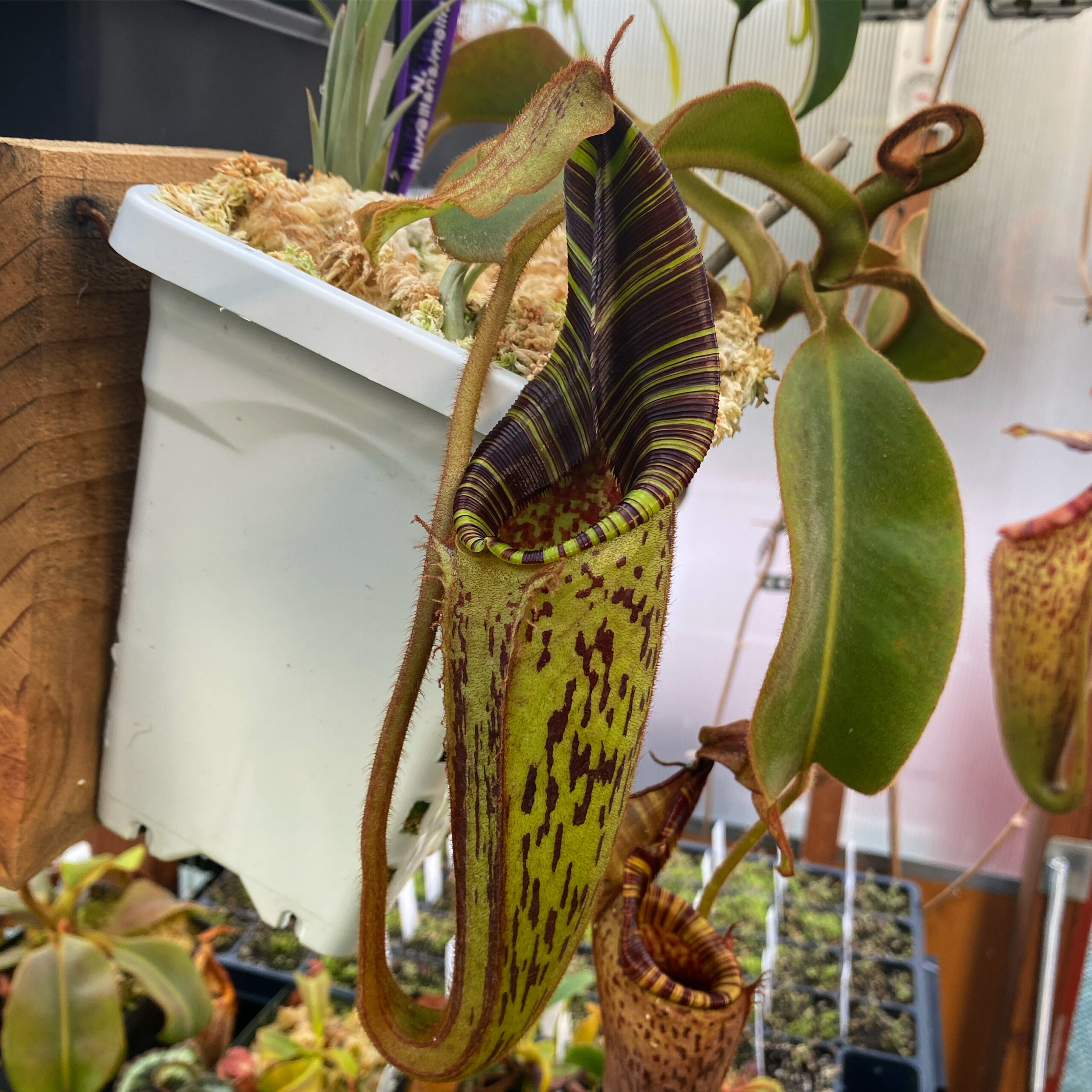Nepenthes

DescriptionNepenthes
Nepenthes are a genus of carnivorous plants that are also known as tropical pitcher plants. These are found in the tropics and do not go through a dormancy period. Nepenthes have shallow root systems with a climbing stem. Each leaf ends with a tendril that develops into a pitcher. Each pitcher or trap contains a self made digestive fluid that traps and breaks down insects that fall into the pitcher.
Nepenthes usually produce two types of pitcher; lower pitchers appear near the base of the plant and typically sit on the ground. These pitchers are generally darker in colour and have wing-like appendages that help terrestrial insects crawl up the pitcher and fall inside. Upper pitchers occur once Nepenthes start to vine into the tree canopy. These pitchers usually change colour and morphology compared to the lower pitchers. This helps them grow up in the canopy and catch flying insects. Most Nepenthes feed on small insects but some of the larger species can catch small vertebrates such as rodents or lizards. Like other carnivorous plants, the additional nutrients from these insects or vertebrates supplements the nutrient poor habitats they have evolved in.
Potting Media
Potting Media
Nepenthes like airy and moist potting media. A popular substrate base is New Zealand sphagnum moss. Perlite and/or orchid bark can be added to keep the moss airy as it breaks down over time. We recommend a 60:40 sphagnum to perlite ratio but they can be successfully grown in pure moss depending on your watering schedule and how often you plan on repotting. Avoid any media with fertilizers such as MiracleGro. Make sure your pot has drainage holes!
Grow Guides
Grow Guides
All Nepenthes enjoy high humidity and air circulation with bright indirect light. Most Nepenthes will be happy in a sunny windowsill or under grow lights. Nepenthes appreciate higher humidity between 60-80% but many can be adjusted to household and windowsill conditions. Nepenthes are tropical plants and do not have a dormancy period.
Nepenthes do not like to dry out but they do not like sitting in water like bog plants. If Nepenthes are kept in deep water for extended periods of time they can develop root rot and decline. Like all other carnivores, Nepenthes appreciate clean water that is low in total dissolved solids (TDS). Depending on where you live, this can be straight from the tap or filtered through a DI or similar system.
You can fertilize your Nepenthes but only fertilize inside the pitchers. A small insect or osmocote pellet can be added to each pitcher once it’s open. Note that overfeeding will cause the pitcher to rot and die.
Temperature depends on the species or hybrid – Nepenthes are generally separated into highland and lowland species. Species that grow in both of these conditions or are hardy enough to grow in a wide range of temperatures are called intermediates. Most hybrids are generally hardy and can be grown in intermediate conditions.
Lowland Nepenthes:
Species that grow at low elevations experience hot and humid days with little temperature drops during the night. These types of plants appreciate temperatures above 70-75F and do not require nighttime temperature drops.
Highland Nepenthes:
Species that grow at higher elevations that experience a temperature drop during the night. These types of plants appreciate day temperatures in the 70-80s and nighttime temperature drop of about 10-20 degrees.
Intermediate Nepenthes:
Species that grow between highland and lowland conditions. They appreciate a temperature drop but are more forgiving than true highlanders. Intermediate species and hybrids can be grown in a wide range of temperatures. We recommend day temperatures in the 70-80s and a nighttime temperature between 60-70F.
Note – These are generalizations and many species and hybrids can be acclimated to intermediate or windowsill conditions. It is important to monitor your plants as they acclimate to your growing conditions. Signs of temperature stress can be aborted pitchers or consecutive leave size decrease. Cold damage or stress depending on the species and/or hybrid can happen under 40-50 degrees. When this happens, they will often develop red mottling on the leaves.
Acclimation Tips
Acclimation Tips
Most plants will arrive unpotted with the root ball intact in potting media. Unwarp the plant from the bag and find a suitable pot for it to live in. We recommend not disturbing the roots and media as much as possible. Instead, just wrap more media as needed to fit the desired pot. All plants are coming from an intermediate/highland tropical greenhouse environment where the humidity is constantly over 70%. Many plants can be acclimated to household and windowsill conditions. If your humidity is low, you can put a bag over the plant as it acclimates. Alternatively, you can keep a shallow tray of water (similar to orchids) to increase localized humidity. Just make sure you are not keeping your Nepenthes in deep standing water. New plants will often drop their pitcher so don’t be alarmed if the current pitchers start to die off. They will make new ones as they grow new leaves. Sometimes adding water to each pitcher will keep them going for a bit but eventually future pitchers will form as your plant acclimates to your conditions. New pitchers will produce the liquid inside and do not need to be filled. Old pitchers and leaves can be cut off with scissors.